
Just like when shopping for a 4x4, some buyers prefer the adventure of custom creating, selecting from a variety of options to build out a total package that meets their needs, while others would rather pay one price for a ready-to roll machine. This is exactly the same with off-grid solar, as there are companies that focus on providing both pre-packaged, matched systems, and individual components for DIY builds. Among the most widely respected of those brands in the North American market is Go Power!
Go Power! offers solutions for RV's, boats and fleet work trucks, with an emphasis on plug-n-play. They both manufacture and sell individually the range of components used in their bundled systems, however it's their packages that can be particularly helpful. Why? As I discuss in more depth in our Offroad Solar 101 article, the number of variables and options in creating a system can make your head spin. That all adds up to a lot of research time…and options for error.
READ MORE: Solar Power 101: Everything You Need to Know About Solar Power
To explore how a built-to-match solar system can avoid all that we reached out to Go Power! last summer to explore what components they would pair up for the typical needs of an offroad/overland rig. The requirements we posed to them were as follows:
- In the backcountry for up to a week at a time
- Year-round usage (i.e., low light months included) situated in the Southwest and Rockies
- Power a range of devices, both A/C and D/C, and
- Pairing with Odyssey PC2150 battery
With the rapid growth of off-grid solar products on the market, we've entered an era where solar options are not only abundant but the risk falling victim to poor quality products flooding the market has become a reality. The durability of these low-end systems, coupled with their sketchy (or non-existent) customer service presents a problem for off-road enthusiasts who count on reliability. Further, such companies typically put the burden on you to spend time (hours and hours usually) researching the correct components to assure compatibility, electrical pairing, and proper connection types.
Go Power!, which is based in Vancouver, BC, has been producing photovoltaic systems and their components since the 1990s, and is among the leaders in doing so for mobile applications. Their systems range from rigid to flexible solar panels, with charge controllers to match, along with their own line of inverters. That one-stop-shopping approach proved more important than we'd realized when first setting out to explore solar system options. In addition, Go Power! offers a wealth of knowledge resources, including its Learning Center.
System Planning
Planning our system began as it should for all buyers with a needs assessment. The technical support team at Go Power! worked with us, posing the right questions, and helping to articulate our most foreseeable uses, as well as our install plan. In addition, the Go Power! web site provides user-friendly system sizing tools to help determine your component needs (e.g., their Inverter Sizing Chart).
Our system needed to provide the power platform for our overland trailer, a Dinoot compact J-Series, offering 12v DC and 120v AC support for uses from laptop to fridge/freezer to area lighting and future devices (e.g., submersible water pump). As a result, it needed to withstand the harsh climate every towable camp faces in the storm of dust and mud that trailers exist in, while still being compact. In short, we designed a system that could serve many an offroad explorer.
Power storage, the "fuel tank" of any solar system, was the Odyssey PC2150, a non-spillable 78lb beast of an AGM. Although Go Power! offers AGM battery solutions, our previous Odyssey had lasted a dozen years, and we've since made them the go-to source for all vehicle starting in our small fleet of vehicles. However, all of the amp hours the PC2150 (100Ah) or any other battery setup offers does you no good if the power generation you're pairing with it is improperly sized. Once again the tech team stepped in to go over our needs.
After some discussion, and based upon our anticipated power draws (e.g., laptop/iPad, 12v camp lights, SnoMaster fridge/freezer), along with a buffer to plan for potentially inadequate solar access (e.g., forested or canyon camp sites), the Go Power! team suggested we use a pair of 100w panels. Based upon ~70Ah daily need, and assuming a targeted 90A to 100A daily production, this system enables a relatively safe two-day stay in camp. To meet this need, the durable Go Power! marine-grade Solar Flex 100 panels were recommended.

While Go Power! offers aluminum framed monocrystalline panels, including their Overlander Kit, the Solar Flex line is tough, and is rated for mounting atop vehicles. A svelte 3mm thick, they can be bowed to mount on surfaces like RV roofs thanks to the white sheet of TPT, a thermoplastic polymer laminate, that forms their structure. The 100w models weigh about 3lb, and cover less than a 2' x 4' area. Each features six embedded metal mounting grommets, along with pigtailed MC4 connectors. The latter is a locking, sealed two-cable male/female system whose roots are in the automotive industry.
The GP-Flex-200 kit includes the pair of 100w panels, a bundled set of 25' MC4 cables, and the company's 30A charge controller. The PWM (pulse width modulation) controller exceeds the output capacity of the panels, ensuring a healthy buffer, and providing an affordable but still effective 'brain' by which electricity is managed as it goes from panel to battery. From a wiring standpoint, the cables' length is ample for even most indirect wiring runs. You can configure a system on a teardrop or other typically sized trailers such as a Chaser or Patriot, or simply locate the highly portable panels amidst optimum sun on the ground.

Go Power! is unique from many solar system manufacturers in that they offer their own line of inverters. While some off-grid users only need 12v DC power, most will invariably want to translate that power into 120v AC so that other devices can be plugged in. Inverting direct current to alternating current to run laptops, corded tools or coffee maker is a central step in every RV, boat, or truck, and makes sense for anyone who is setting up a solar system. Go Power! inverters range from small 175w units to the largest 5000w heavy duty modified sine wave model. Key to their differences are "modified" versus "pure sine wave" inverters. The latter provide "clean" 120v current that matches a household plug, and is reliable for sensitive electronics.
If you are like us, running devices ranging from a MacBook to a 6A angle grinder is a must when selecting an inverter. Go Power! Business Development Manager Sean O'Connor advised that a safe margin was best to build in, and advised a 2000w capacity. In addition, the critical need for a pure sine wave model meant the best fit came from the GP-ISW2000. Rated at a surge capacity of 3500w, this burly inverter weighs nearly a dozen pounds, and features 2 GFCI outlets. It can be conveniently paired with the #4 install kit, which includes beefy 2/0 cables and a shielded 300w Class T slow blow fuse block. If needed, Go Power! also offers remote monitors for their inverters.
First Impressions
All of the Go Power! components come professionally packaged, with ample padding, in sealed/Ziploc and clearly labeled bags, and within sturdy, well-marked boxes. The panels themselves come protected by an easily removed clear film on the photovoltaic side, which is left on until mounting is complete. The system comes complete with all necessary zip ties, cable ends and anchors.
When it comes to instructions, Go Power! products are detailed, clear and thorough, erring a bit more towards the electrical geek's interest in spec's than a dumbed down set of paperwork. Included are important considerations such as wiring sequence, electrical safety and ratings. Apart from the depth of the guides, the only other issue we saw related to some discrepancies in recommended wire sizing/length, as the spec's in places differed slightly (e.g., max length of run from inverter to battery).
One of the advantages of this and other Go Power! systems is the capacity to expand power output through the addition of an expansion kit. While we don't foresee needing more than the 11.2A that this system affords us, it's comforting to know that the company has designed in the option should a change of power demands and/or diminished access to solar rays (e.g., from moving to a more forested region) occur in our future.
Less evident in the Solar Flex kits are the advantages provided in the remaining components. Cable management is easy to overlook until, that is, you start an install. And then it's very clear why it pays to have this facet of your system pre-designed to match. Go Power! offers fuse blocks and additional cable sets to cover every connection in the system as well as those for system expansion, with each being load matched to the remaining components. This takes the guesswork out of crafting a system for your needs.
Installation
So how to configure all of these electrical components? Go Power! installation instructions will guide you through many of the basic decisions, such as wiring and clearances for cooling. However, once you've decided to go with a permanently mounted system, planning the layout needs to be carefully thought through. Most offroad trailers and their tow vehicles are as unique as their owners, and thus ideas for configuring their interiors and exteriors is customized.
For instance, on our Dinoot compact trailer, creating a dedicated weatherproof enclosure was critical. In addition, rather than adding an additional 150lb to the tongue, a rear-mounted design was used (i.e., using a below frame battery mount for improved center of gravity). Only the panels were forward-mounted, enabling easy access for repositioning. The Go Power! system allows for these customized configurations.
No solar panel can overcome poor alignment or blockage of sunbeams, and the Solar Flex is no different. In testing for portable (i.e., unmounted) charging scenarios we've used the Solar Flex panels with good success. After selecting a quality system like the Solar Flex-200, the most critical factor to electrical output is unimpeded, direct rays from the sun. As I discuss in more detail in our Offroad Solar 101 article, this means optimizing the perpendicular alignment of your panels to the sun, and eliminating even minor shading (or related diffusing of rays, such as from dirt or leaves). Most manufacturers leave the solutions for how these factors are addressed to the consumer.
That means you either physically situate portable panels (typically on the ground) for best performance, or you orient the vehicle/trailer on which fixed panels are mounted to optimize rays. On the ground, Solar Flex panels' semi-rigid TPT backsheet allows them to be propped up to hold an angle. The built-in grommets allow easy hanging or tie downs. Paired with a system like Goal Zero's Yeti line, which includes its own charge controller, the Solar Flex panels can be purchased to provide solar collection for such all-in-one systems. The MC4 to Goal Zero (8mm input) adapter cable makes this connection simple and reliable.
Most flexible panel users only benefit from their pliable structure in how they mount to a vehicle's curved surface, such as an RV's roof. We saw another opportunity in the Solar Flex panels. Coupled with a rotating base, these panels allow an inherently strong bowed mount (up to 2.7" bend). The Go Power! panels' construction inspired this method, though there are numerous other configurations a user could devise.
Unlike fixed roof mounts, our goal was to create a mount with adjustable orientation to match the sun's arc while preventing the need to relocate our trailer. The resulting 2-axis mount can be quickly positioned to face the sun, while still charging during travel (or shorter parked times) in its flat, stowed position. And while portable (e.g., foldable/rollable) panels need to be hung or laid out to capture precious rays, our system both elevates the panels above ground vegetation (which can kill solar production) and takes seconds to rotate to the shift sun. With a bit of forethought in how we park, it even rotates the 180 degrees to face both sunset and sunrise, as well as the full arc of the sun throughout the day, and offers 48 different locked positions. The Solar Flex panels lend themselves to the light metal frame we mounted them to, using stainless steel bolts and 3M double-sided VHB tape to secure each array. Their strength grows with the slightly curved mount, again demonstrating the benefits of flexible panels.
Performance
If you're wondering where the rub is with flexible, thin film monocrystalline panels the answer is not merely cost. Translating the sun's rays to usable electricity is far from a 1-to-1 enterprise. The most efficient panels, such as commercial grade, rigid models from the likes of industry leader SunPower today top out at 22% efficiency. By comparison, the more efficient lightweight, portable monocrystalline rigid panels typically provide 14-17% efficiency. Solar Flex panels boast an impressive module efficiency of >19%.
Despite this outstanding efficiency level, like any PV system, the Solar Flex units rely upon two key margins being in place. First, the total panel wattage needs to allow for imperfect conditions via upsizing. While online solar system calculators inferred a single 100w panel should be adequate to cover our needs, only a fool counts on optimal environmental conditions and panel performance. Upsizing total wattage helps create your needed margin.
Similarly, when it comes to system storage, upsizing battery capacity adds a buffer for overcast days, camping amidst trees, or high wind conditions when panels can't be arrayed. Doubling your minimum projected amp hours of battery capacity may be the margin some conditions demand. Go Power! offers the Australian Sun Cycle battery line of AGM deep cycles, featuring 100Ah capacities. In our case, having a dual battery system (Odyssey PC1500 and PC1750) on the Land Cruiser meant less need for a second battery on the trailer.
To date, our Go Power! system has readily met our needs, providing a mobile electrical system for multi-day trips. The most challenging tests have been the reduced solar access of fall and winter in the Northern Wasatch Range, along with the physical exposure a trailer-based system faces. The quality of the Solar Flex system has met our needs, and provided the adaptability to customize it to the Dinoot trailer, along with adaptable install and power usage.
Collecting adequate amps of electricity is pretty reliable with the twin 100w panels. Even on a recent December day, the pair produced 140w+ from available low angle light. Similarly, the 2,000w capacity of the Go Power! inverter has proven to be the right blend of versatility for our usage, and should be more than sufficient for most applications, and offroad enthusiasts. In contrast, our "weak link" in our system is now likely the single 100aH Odyssey PC2150 battery, though its proven durability and ability to handle deep discharges is more than enough for most users.

The Go Power! 30 Amp Controller (GP-PWM-30), though not a more advanced MPPT, can still produce reasonable output from the panels and is an affordable compromise. Most such PWM controllers are susceptible to reduced performance in temperature extremes, though we have not experienced that as a problem. However, that is a limitation to bear in mind if climates you will operate in fall into those ends of the spectrum. To serve consumers who have this need, Go Power! will be releasing a new MPPT controller in 2018.
What would we change? First, the PV wiring provided with the Go Power! kit is stiff. Though durable, the sheathing is challenging to route in tight spaces and corners. This is an installation factor, but once in place it doesn't rear its head again. A more lasting wish is for the 30-amp Solar Controller to offer more of a full featured access to power. The lone USB port is really handy, but with today's proliferation of iThings the module should be a full-fledged "control center", including both more USB ports and possibly other common connections.
This holds true for the other power interface, the otherwise capable (though rather large) GP-ISW2000 inverter. With DC power flowing in, all inverters need to become more feature-rich. Most are dated designs from the past, and need modernizing to allow users a one-stop access to 12v as well as 120v electricity. Finally, for usage on the trail, the rubber dust/moisture plug for the Controller's USB port is too easily lost. Once removed, it's quick to disappear. It should be tethered or an otherwise fixed means to assure reliable sealing of this orifice from ever present grime.
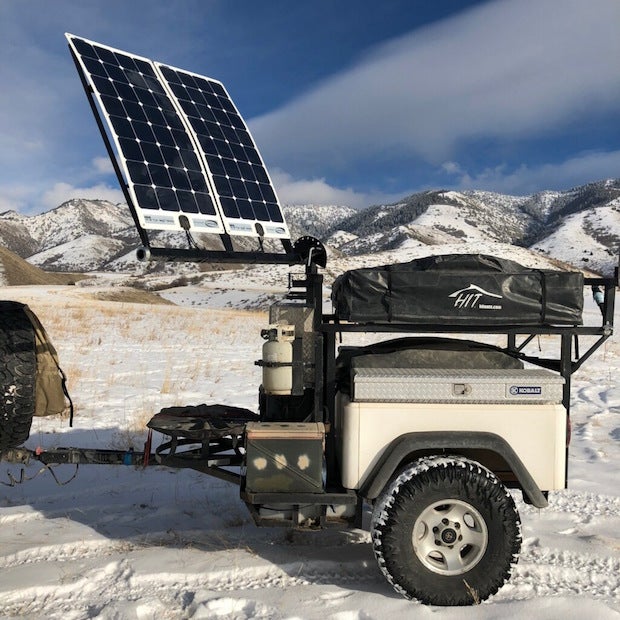
Summary
Go Power! offers users a one-stop-shopping solution to finding quality, affordable solar systems in flexible and rigid configurations, including pure sine wave inverters. Their matched components and range of wattage outputs give those who don't want to immerse themselves into the morass of solar research a reliable way to quickly get set up for power. Coupled with their wealth of online information, and their helpful technical staff, they're a reliable source for setting up your own solar system for the trail.
Want to hear more about the Go Power! products? In addition to our own testing, two other experienced Go Power! users, who each live off the grid have shared their experiences from the RV community point of view (see Gone With the Wynns).
Their experiences offer the benefit of hearing about the Solar Flex systems in full-time solar living, as does the rigorous usage by Marc Wassmann of XPCamper.

About the Gear Doctor
Sean Michael has been designing, abusing and testing outdoor gear since the 1980's. He began reviewing for Off-road.com in 2000, and today lives in the Northern Wasatch Mountains, where he is Director of the Outdoor Product Design & Development [LINK to opdd.usu.edu]. program at Utah State University. Follow his trips and gear at thegeardoctor in Instagram.

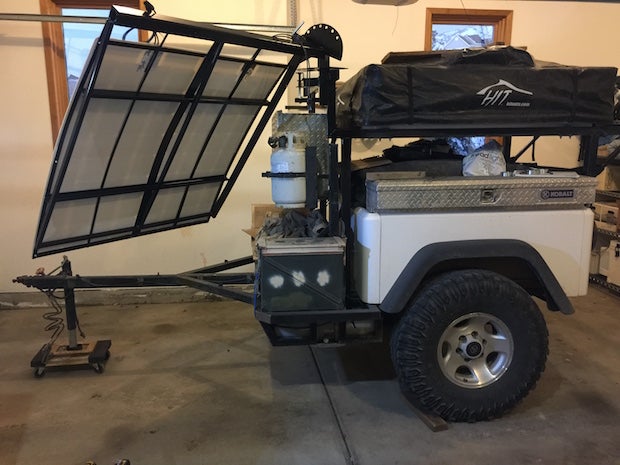
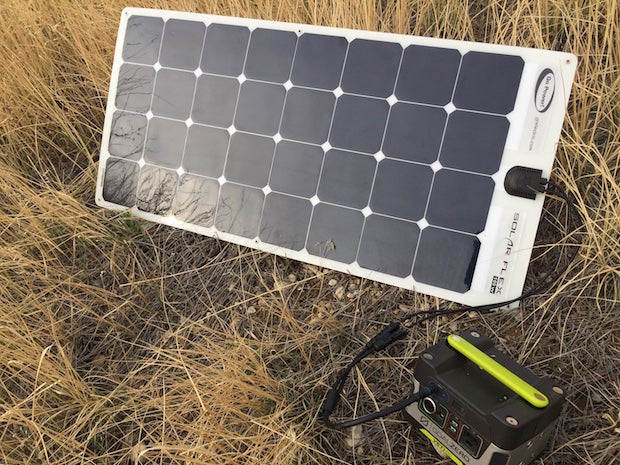
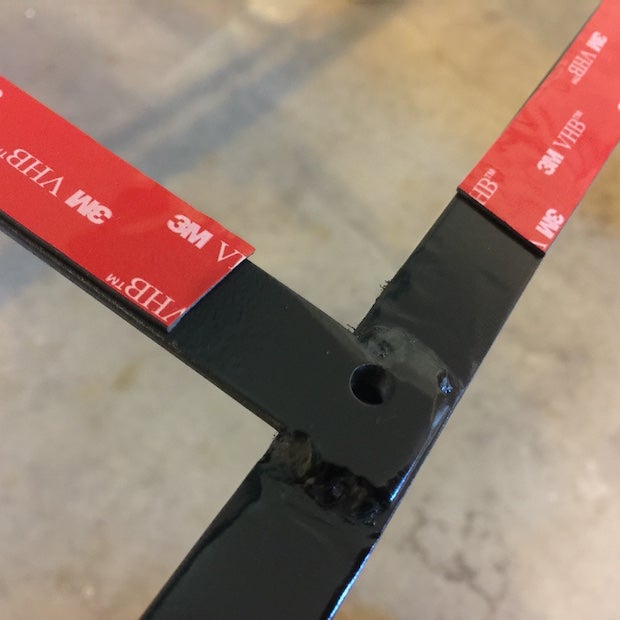
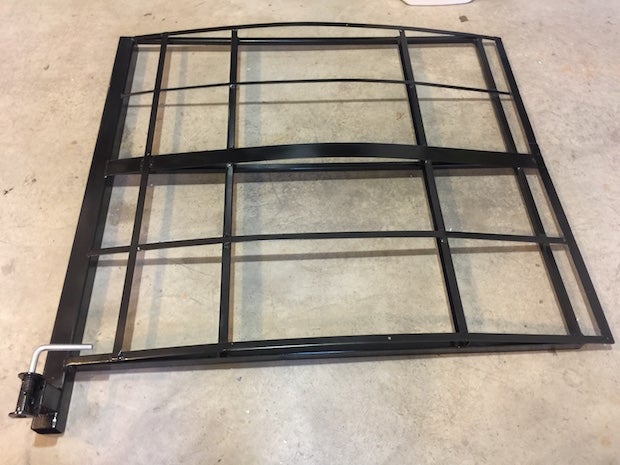

 Your Privacy Choices
Your Privacy Choices